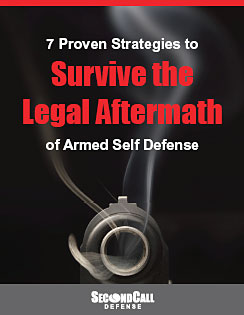In self defense, how many shots are justifiable?
If you’ve been following the story about the shooting in Ferguson, MO, you may have noticed a familiar pattern.
While the general public knows very little about the reality of violence or the use of lethal force, that doesn’t stop people from having strong opinions anytime someone gets shot. This is especially true when it comes to how many shots are fired.
According to one long-standing statistic, most self defense shootings involve an average of two shots. But that’s an average, meaning there are a lot of incidents with fewer and a lot with more.
Anyone who has ever taken a firearm defensive class from a competent instructor knows that in a life-or-death situation, you should shoot until you perceive the threat is over. That means shooting multiple times to the chest and/or head. At the very least, students are told to do a “double tap,” meaning two shots minimum.
But to listen to some of the news coverage of the Ferguson case, you’d think that multiple shots are evidence of murder.
Here are the basics of this case.
On Saturday, August 9, 2014, there was a confrontation between 18-year-old Michael Brown and 28-year-old police officer Darren Wilson in Ferguson, MO. Details are still a little fuzzy at this point about what happened and why. It may have been related to a convenience store robbery or it may have resulted from a chance encounter between the officer and the young man.
According to a report in USA Today, St. Louis County Police Chief Joe Belmar said “Brown physically assaulted the officer, and during a struggle between the two, Brown reached for the officer’s gun. One shot was fired in the car followed by other gunshots outside of the car.”
Some alleged eye witnesses, on the other hand, claim the shooting was unprovoked and the officer shot Brown as he ran away or as he was surrendering.
Regardless of how the facts play out over the coming weeks or months, let’s assume just for the sake of discussion that the police officer was honestly in fear of death or great bodily harm and shot Brown in self defense.
A preliminary autopsy report released on Monday, August 18 showed that the police officer fired at least six shots, four landing in the arm and two in the head. It’s unclear whether other shots were fired and missed.
Is that too many shots?
In response to the autopsy report, Brown family lawyer Benjamin Crump said, “It verifies the worst that the family thinks happened — that he was executed. It confirms what the witnesses said, that this was an execution. That’s what the witnesses said from day one.”
You might expect a prosecuting attorney to bend facts in his favor, but the idea that six shots are too many and indicate evil intent has been a regular theme of the media coverage and “man on the street”
interviews even before Crump’s statement.
Why? Is it because movies and TV teach us that one shot is all it takes to stop someone? Maybe, but whatever the reason, reaction to multiple shots is almost universally negative regardless of the facts.
How many shots does it actually take to stop an attack? Maybe one. Maybe 20. It depends on many factors, including shot placement, the physical condition of the attacker, whether or not certain drugs are involved, etc.
Medical examiner Dr. Michael Baden claimed in a public statement about his own autopsy in the Ferguson case that five of the six shots were survivable. It was, in his opinion, one shot to the head that stopped and killed Michael Brown. He also said he believed the head shot was the last shot fired.
So one shot was required, but apparently it took six shots to land the one critical hit.
If you believe the police statement about the shooting being self defense, we could say six shots were reasonable. If you believe the alternate scenario, that the officer “executed” the young man, then even one shot was too many.
There are negative perceptions about more than just multiple shots. The media constantly refer to the teenager as “unarmed,”
suggesting that only those with firearms pose a threat. The lethal shot to the head prompts many people to suggest that the officer purposely administered a coup de grâce shot. Even a video showing the officer pacing up and down the street following the shooting says to some self-appointed experts that the officer was guilty of murder because, they believe, he should be reacting in some other way.
Again, we don’t have all the details about this incident so it’s unfair to arrive at opinions just yet. But there are two takeaways from this shooting.
First, most people are terribly misinformed about the reality of self defense. This includes not just the general public, but unfortunately, the media and many legal “experts”
and prosecutors who give credibility to bad information.
Second, while you need to be willing to do what you have to do to survive an attack, you need to also be prepared to deal with the ill-informed opinions of those who may become involved in a legal case against you.
If everyone were truly reasonable and well-educated about self defense, you would have nothing to worry about. Sadly, this isn’t the case.
“

